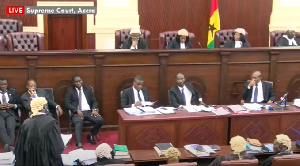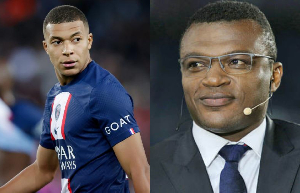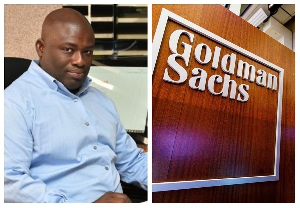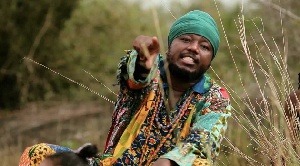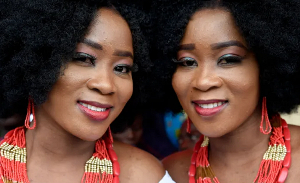Opinions of Tuesday, 4 July 2023
Columnist: Fusheini Yakubu
Interrogating the Konkomba pre-condition to peace in Ghana: The nagging issues
Introduction
In recent times, occurrence and reoccurrence of war mongering laced social media posts by some elements believed to be Konkombas inciting hatred against Dagombas, has generated tension, suspicion, and mistrust between the two ethnic groups.
This is unfortunately not only bringing back to memory, the painful loss of thousands of precious lives and property, dislocation and emigration associated with armed conflict between Konkombas and other Northern ethnic groups in the 80s-90s, but also, generating fears of the possibility of a yet another armed conflict between Northerners in their own backyard.
The context
Aside the social media hate messages menace, another emerging paradigm is two Konkomba chiefs adding their voices by holding press conferences and granting interviews to local FM stations.
The two chiefs unusual of traditional rulers threw all courtesies to the dogs sought to openly set pre-conditions for peace. Peace can only prevail if only Konkomba demands on land related matters are met and minus that there can never be peace. This sad development tends to lend support to the various war threatening social media posts and heighten tensions between Konkombas and their neighbours.
KOYA’s intervention
Wading into the development, the Konkomba Youth Association (KOYA) in a Press Release dated,27th June,2023 sought to allay the fears of other tribes in the Northern region to disregard the war threats of persons “claiming to be Konkombas.”
“We at KOYA hereby directs all Konkombas at home and abroad never to respond to any inciteful statement or statements from any persons or group of persons on behalf of Konkombas unless otherwise directed by KOYA or our chiefs.”
Kpakpaando’s submission
The following day, June 28,2023, a press release signed by the Chairman of Nkpakpaando, Saboba, unlike KOYA that had earlier craftily tried to water down issues, without any ambiguity declared their stance. Kpakpaando in its press release in question, gave its full backing to all what the Konkomba chief who had earlier granted the FM interview had said.
He spoke categorically that, Dagombas cannot claim their lands in the Eastern corridor and as such, the yet to be adopted Dagbon constitution must therefore exclude the Konkomba owned lands.
“We further call on well-meaning Konkombas to resist an oppressor’s rule within and without and stand firm against any injustice. Every Konkomba has the right to talk about issues that bother our generation and the future generations Nobody has a monopoly over matters affecting our lives as a people. Nobody should be intimidated either internally or externally” the Kpakpaando press release signed by its chairman, said.
In a video tape by Maranatha FM at Nungua, in the Greater Accra region that granted a number of interviews to a purported chief of Konkombas and Basaris of Tema, Greater Accra region, Ubor Magal Kuunboln I, whose position Nkpakpaando supported in its press release, indeed had added to the already existing tension between Konkombas and their Dagomba neigbours.
The contentious issues raised during the interview were the following:
Konkombas take exception to the inclusion of Konkomba towns in a written Dagbon Constitution which is in the process of getting the nod formally by the state of Ghana. His beef was that lands within the Eastern Corridor enclave inhabited by Konkombas belongs to them exclusively and not Dagombas and so the yet to be approved Dagbon constitution shouldn’t include the said areas as part of Dagbon. According to the chief those lands was a no man’s land where the ancestors of the Konkombas had settled before the arrival of Dagombas.
Determination of who becomes a paramount chief among Konkombas by Dagombas, was also unacceptable. Konkombas, he opined, are considerably a large ethnic group and therefore it is unacceptable that another tribe (Dagombas) with different culture and traditions should subject them to their traditional authority in their own land which is never part of Dagbon.
The Chief blamed the late General Acheampong-led Supreme Military Council (SMC) Regime for engaging in Acts that tended to favour Dagombas over Konkombas citing an Alhassan Committee.
He also blamed the British colonial government for playing a role in their being subjugated to Dagbon’s rule.
The chief no doubt was drawing from a 22-page article, full of doctored history which tends to misinform some fellow Konkombas influencing them against their Dagomba neighbours to perceive them as oppressors and which shouldn’t have been the case at all.
Considering the content of the Konkomba Youth Association (KOYA) press release dated, 27th June,2023 calling for calm in the Northern region, one keeps wondering what it had done about the 2021 press conference by the Kpandai Konkomba Chief, the recent interviews by Maranatha FM at Nungua, Accra with one Ubor Magal Kuunboln I and the press release by NKPAKPAANDO AABƆMUKL on 28th June 2023. The statements by the various bodies and individuals contradicts each other.
Jonah Kolimba in an opinion piece titled, "KONKOMBAS ARE NOT STRANGERS IN GHANA” endorses the foregoing view point with details and states that Saboba, Gnani, Sanguli, Yajol, (Zabzugu), Kpassa, Damonko, Namong, Gbindiri, Wapuli and many others are Konkomba towns. Thus, the inclusion of Saboba, Tatale and Sanguli as Dagomba towns in Constitution of Dagbon is unacceptable to Konkombas.
Konkomba doctored Mole-Dagbani history
On page 12 of an article packed full of distortions of historical facts and deliberate disinformation by Kenneth Kitinkawa and George A. Badak, titled,” The True Ownership of Lands and Position of Tenants in The Northern Region of Ghana they falsely claimed that “Mole Dagbani Group arrived in Dagbon in the 16th century.” Just a mere statement without scientific backing, is a doctored history to change the narrative of the rich Dagbon history to suit the parochial ethnic whims and caprices.
True mole Dagbani history
The true history of the Mole Dagbani linguistic group (Dagbamba, Mamprusi, Nanumba, Moshie among others) is known by both Mole Dagbani and non-Mole Dagbani historians.
Archeological findings at old Yendi (Yani dabari)
Contrary to the Kenneth Kitinkawa and George A. Badak Konkomba claim that the Mole Dagbani arrived in Dagbon in the 16th century, according to Shinnie and Ozanne, the archaeological investigation conducted at Yani Dabari (old Yendi), revealed that Naa Gbewaa came to Great Dagbon (Modern Dagbon, Mamprugu and Nanung) in the 13th century.
The Kpandai episode
A press conference organized by Konkombas in Kpandai with a video tape on the event widely circulated on social media in 2021 is a spectacular case in point.
In the video tape in question, the Konkomba Chief in Kpandai, Ubor Bignalib Mangan among other things, made a passionate appeal to the Government of Ghana “to ensure that Konkombas are recognized as Ghanaians and also find a land for them to be called their home, otherwise, there will be no peace”.
This statement by the Konkomba Chief in Kpandai, Ubor Bignalib Mangan in 2021, further confirmed their status as strangers-settlers not only in the Northern and North-East Regions but the whole Ghana.
Also, it contradicts the claim by Mr. Kenneth Kitinkawa and Mr. George A. Badak in their 22-page doctored Konkomba-Dagomba history article,” The True Ownership of Lands and Position of Tenants in The Northern Region of Ghana” that says inter alia, “as already mentioned historically, Konkombas and the Guans ethnic group were the first to arrive in the present-day Ghana around the 12th century”.
Anyway, his appeal to the Government of Ghana was a good one, but unfortunately, Lands in Ghana are owned by traditional rulers except lands that were acquired by the Government of Ghana for public good or interest and declared “Public Lands by Article 257 of the 1992 Constitution of Ghana”.
Considering the content of the Konkomba Youth Association (KOYA) Press Release dated, 27th June,2023 calling for calm in the Northern region, one keeps wondering what it had done about the 2021 press conference by the Kpandai Konkomba Chief, the recent interviews by Maranatha FM at Nungua, Accra with one Ubor Magal Kuunboln I and the press release by NKPAKPAANDO AABƆMUKL on 28th June 2023. The statements by the various bodies and individuals contradicts each other.
NB: In a 23-page article titled, "Konkomba False Claim and Doctored History’, that is to follow this prelude, I have provided an evidence based full scale interrogation of the doctored history accounts presented by the duo in order to set the records straight and to the fair mined reader sieve the chaff.
Mr. Kenneth Kitinkawa, and Mr. George A. Badak article is full of false claims, doctored history, expression of emotions, insults of former Head of State, Public Institutions and threatening of other ethnic groups in other to achieve their mischievous and parochial ethnic agenda.
The Konkomba Blame of late General Acheampong/ British Colonial Government: The Facts About the Matter.
Konkomba spokes persons in recent times have blamed the late General Acheampong-led Supreme Military Council for sharing lands in Ghana without giving Konkombas their due share.
It is important to note that Lands in Ghana are owned by traditional rulers except lands that were acquired by the Government of Ghana for public good or interest and declared “Public Lands by Article 257 of the 1992 Constitution of Ghana”.
Based on this background, how could Government and for that matter, late General Acheampong-led Supreme Military Council distribute lands in Northern Ghana to some ethnic groups and denied others? Permit me to present synopsis on the legal history of Northern Ghana lands. The British indirect rule declared lands in Northern Ghana as “public lands”.
In 1927 the “Land and Native Rights Ordinance of the Northern Territories was proposed. The reason for the Ordinance was to declare all lands in Northern and Upper Regions “Public Lands”.
The proposal triggered an outcry in the then Legislative Council of the Gold Coast and Honourable Casely Hayford, a then member of the Legislative Council was said to have labelled the Ordinance as 'Confiscatory'. The “Gold Coast Spectator” also commented adversely on the Ordinance.
On the 21st of November 1931, the “Land and Native Rights Ordinance of Northern Territories” Cap. 147 was passed, vesting control of lands in the Northern and Upper Regions in the Governor.
In December 1977, the National Redemption Council approved in principle a memorandum from the Ministry of Lands and Mineral Resources to repeal Executive Instruments 87 & 109 of 1963 to enable ownership of the lands in the Northern and Upper Regions to revert to the Traditional owners which include chiefs, Tindamba, Clans, and families.
To ensure smooth transfer of the lands to Traditional owners, the Commissioner for Lands and Mineral Resources formed a committee “COMMITTEE ON OWNERSHIP OF LANDS AND POSITION OF TENANTS IN THE NORTHERN AND UPPER REGIONS”, Ministry of Lands and Mineral Resources 1978 Committee report on Ownership of Lands and Position of Tenants in the Northern and Upper Regions, P.1/2.
The late General Acheampong-led Supreme Military Council facilitated the process to return lands from the Northern and Upper regions of Ghana to their traditional owners. As such, late General Acheampong-led Supreme Military Council never distributed land to any ethnic group in Northern Ghana.
The control of these lands were taken away from the traditional owners and vested in the British Colonial Governor. It is very important to note also, only Northern Ghana lands were vested in the British Governor and declared “Public Lands”. These lands were under the control and management of the British Colonial Governor for 46 years. Southern Ghana had absolute control over their lands without any interference from the British colonial rule.
Kumasi Accord on Peace and Reconciliation Between the Various Ethnic Groups in the Northern Region of Ghana.
The findings by the Ministry of Lands and Mineral Resources, 1978 Committee on Ownership of Lands and Position of Tenants in the Northern and Upper Regions of Ghana, the verdict delivered by the Stool Lands Boundaries Settlement Commission and the agreements signed by both Konkomba and Nanumba delegations in [1996] Kumasi Accord on Peace and Reconciliation Between the Various Ethnic Groups in the Northern Region of Ghana, corroborated.
Lands in Nanung Kingdom, are the ancestral lands of Nanumbas and the allodia title is vested in Bimbilla Naa, who holds same as a trustee, in trust for the sons and daughters of Nanung Kingdom.
The same holds true for its sister Kingdoms of Dagbon and Mamprugu where all ancestral lands and their allodia titles is vested in their Royal Majesties, the Yaa Naa and the Nayiri respectively. They hold same as a Trustees in trust for the sons and daughters of their respective Kingdoms.
The Kumasi Accord to which Konkombas were signatories also stipulated that His Royal Majesty, the Yaa Naa by his personal discretion could elevate chiefs in Dagbon to Paramount status and which the purported Tema Konkomba/Basari Chief is now detesting?
The peace and security threats by Konkombas is not limited to Dagomba, Nanumba, and Gonja ethnic groups, but also other ethnic groups such as, the Nchumuru, Nawuri, and Anufor ethnic groups.
Dossier of Konkomba violence against other ethnic groups
In 1994, Konkombas attacked six (6) administrative districts in the Eastern Corridor of the Northern Region. The districts included, East Gonja, Nanumba, Zabzugu/Tatale, Yendi, Gushegu and Karaga.
The ethnic groups in the various districts were, Gonjas, Nanumbas, and Dagombas. The conflict was dubbed “The Guinea Fowl Conflict.”
Nanumba and Konkomba Conflict, 1981 dubbed “Baatu Conflict)
The Bimoba and Konkomba Ethnic Conflict is not an exception in 1982, 1983, and 1985.
Dagbon has experienced several conflicts with Konkombas since 1940s.
These conflicts and warfare include “The Cow Conflict at Zagbeli in 1940 between Dagombas and Konkombas”
“The Fish Conflict at Sambuli in 1946 between Dagombas and Konkombas.”
The recent conflicts and warfare by Konkombas are,
Konkomba and Anufor Conflict from 2019 – 2022
Konkomba and Nchumuru Conflict in 2022.
The recent physical and verbal attacks by Konkombas on other ethnic groups in the Northern Region, is a clear indication that the Konkomba menace don’t seem to have an end and even assuming a countrywide dimension.
The moral question
If inclusion of ‘Konkomba lands’ in Dagbon constitution is what would be resisted as modern-day colonization of Konkombas by Dagombas, so what of the demand by Konkombas for non-Konkomba lands in Kpandai minis which there will be no peace as stated by the Konkomba chief in Kpandai during a press conference in 2021?
Did the ancestors of the Kpandai Konkombas also precede those of the ancestors of the local people there too like is purported to be the case in Dagbon? If yes, why then the demand now being made for land and also asking to be recognized as Ghanaians? If no, then that also constitutes modern-day land colonialism and oppression of indigenes by settler farmers on their own land.
Considering the dossier of Konkomba armed conflicts and warfare with various other Ghanaian ethnic groups across the country, is it the case that all the tribes who fell victim to Konkomba violence were wrong and Konkombas were always right? Are all the various ethnic groups oppressors and modern-day colonizers?
The State Authorities should prioritize this early warning signal and accord it the needed attention to prevent any conflict and warfare that may occur in the Northern Region.
This article is intended to serve as a prelude to my more detailed 23-page article titled,” Konkomba False Claim and Doctored History’ to follow shortly. It is in response to the article by Mr. Kenneth Kitinkawa, and Mr. George A. Badak full of false claims, doctored history, expression of emotions, insults of a former Head of State, public institutions and threatening of other ethnic groups.
From all indications, such motives are intended to achieve a parochial ethnic agenda rather than a collective Northern agenda badly needed to bridge the long-protracted South-North development gap.



